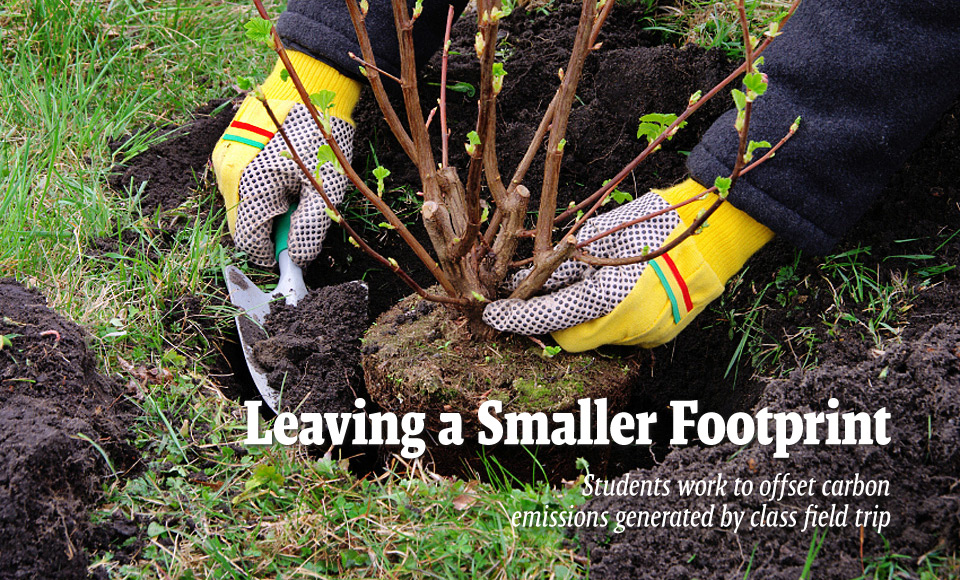-
Page Navigation Links:
- Skip to Site Navigation Links
- Skip to Features

- The University of Iowa
- Spectator
- Monthly News for UI Alumni and Friends
![]()
Visit the U.S. Environmental Protection Agency or The Nature Conservatory to estimate how many tons of carbon dioxide and other greenhouse gases your actions contribute to the environment each year, and learn about what steps you can take to reduce your carbon footprint.
Three vans travelling 3,000 miles can leave an awfully big carbon footprint—a 6.2-metric-ton footprint, to be exact.
That massive footprint was the one potential downside to the 10-day field trip that was the capstone of UI professor Art Bettis’ spring semester geoscience course, Geology Field Trip: Selected National Parks. The College of Liberal Arts and Sciences course, which met once a week during the spring semester, focused on the geologic, biologic, and cultural resources of the National Park System, as well as management and environmental issues. It concluded with a 10-day trip to Florisant Fossil Beds and Great Sand Dunes National Parks in Colorado and Tent Rocks National Monuments and Valles Caldera National Preserve in New Mexico.
So, at the beginning of the semester, Bettis issued a challenge to the 15 students in his class: find a way to offset that carbon in order to neutralize the environmental impact of the trip. He didn’t require the students to participate in the challenge, but every one of them wanted to get involved.
“They were all for it right away,” he says. “They have just taken the ball and run with it. I think most students are just dying to do something that will help solve a bigger problem in the community.”
A big footprint required a big project, so the class partnered with the city to plant more than 1,000 native Iowa shrubs at Sycamore Greenspace, a city park and wetland area that was constructed for storm water management. About 900 ninebark, nannyberry, and arrowwood shrubs were purchased by the city from the State Forest Nursery in Ames; another 150 were donated. In addition, Lon Drake, professor emeritus of geoscience, donated 50 elderberry and coralberry shrubs.
The shrubs will sequester about 6.2 metric tons of carbon in about three to five years, Bettis says.
They’ll also beautify the area and help create a wildlife habitat for native birds and other animals in the park, says Brenda Nations, environmental coordinator for the City of Iowa City.
“This is a great partnership for us,” Nations says. “One of our goals as a city is to lower emissions within our community, and anything students can do in that area is a huge help. I’m really excited that students are getting this as a part of their education. With this project, they’re getting a hands-on education in a new environment, and, of course, we’re getting the help of their labor.”
Bettis’ students planted the shrubs in late April and early May. Volunteers from Kirkwood Community College’s Environmental Club and Iowa City’s City High School pitched in, too.
“I’m really excited that this is the direction we decided to go,” says UI junior Eric Tripp, a chemical engineering major from Burlington, Iowa. “It’s something that’s really visual, and helps quantify the effects of our actions. This project not only helps solve a problem, but also helps people perceive the size of the problem.”
In addition to being enrolled in Bettis’ class, Tripp is in the middle of an energy efficiency auditor internship with the Iowa City Public Works Department.
Other steps students took to reduce their carbon footprint included taking the bus, walking, or bicycling instead of driving; eating more meatless meals; composting; and using less water.
“I think this was a really cool way to get people thinking about environmental issues,” says UI junior Emmalyn Kayser of Des Moines. “As an environmental science major, these things are always on my brain, but I took a similar road trip on my own last summer, and I didn’t even think twice about the carbon I was putting into the atmosphere. I was just super excited to go on the trip. Now I feel like I’m ‘paying back’ the environment for both that trip and this one.”
—Anne Kapler
photo from istockphoto
© The University of Iowa 2009
